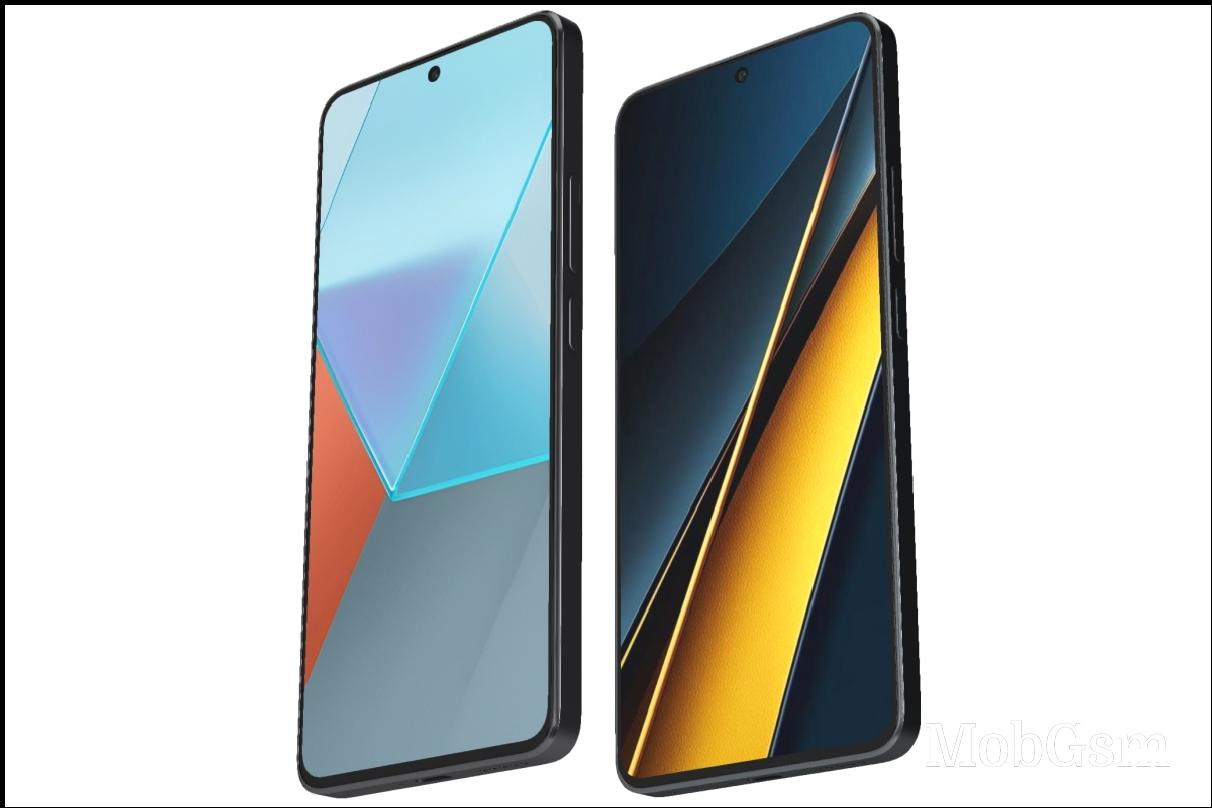Xiaomi Redmi Note 13 Pro vs. Xiaomi Poco X6 Pro
So, you"re looking to buy a Xiaomi midranger and spend around €300 in the process. Surprisingly, there is no shortage of options, but the two you are probably most likely to encounter are the Xiaomi Redmi Note 13 Pro and the Xiaomi Poco X6 Pro.
The two share a lot of specs and offer a very similar overall experience. The Redmi Note 13 Pro is technically the cheaper of the two, but only if you look into the base 128GB/8GB version. The Poco X6 Pro has a 256GB/8GB base tier.
The Poco also has the more powerful chipset, but the Redmi arguably has the upper hand in the camera department. But we"ll get to all that in a moment.
Table of Contents:
For starters, you can compare the complete specs sheets or directly continue with our editor"s assessment in the following text.
Size comparison
The Redmi Note 13 Pro and Poco X6 Pro are quite comparable in overall size. It makes sense, given that both phones are rocking the same 6.67-inch diagonal 20:9 displays. The Redmi has slightly bigger bezels and is slightly taller. However, the difference is hardly noticeable. Interestingly enough, the Poco is a bit thicker, even though the Redmi has a slightly bigger battery.
Speaking of display bezels, both phones are reasonably small, with around 89.8% screen-to-body ratio on the Redmi and around 90.1% on the Poco. Both phones also have very reasonably sized selfie punch holes. Nothing excessive. Both have identical under-display fingerprint readers and pretty much no other visible sensors or I/O on the front. Both phones are pretty much flat on both sides.
Apart from the camera islands, the two phones have a similar overall design language, including plastic middle frames with a metallic-like coating and nicely rounded corners.

Speaking of materials, the two phones are quite similar in their overall build. Both phones also have IP54 ingress protection The Redmi Note 13 has a slight advantage in this department with its Gorilla Glass Victus front, compared to Gorilla Glass 5 on the Poco X6 Pro. Other than that, both phones, as mentioned, have plastic frames and plastic backs. Unless you get the Poco with a silicon polymer (eco-leather) back. .
In terms of color, the Redmi has a wider selection, including Midnight Black, Aurora Purple (Coral Purple), Ocean Teal and Arctic White. In contrast, the Poco X6 Pro only has three color options: Black, Gray and Yellow. But that last yellow one is pretty interesting since it features an eco-leather back.
Both phones also have stereo speaker setups with an amplified earpiece acting as the second channel. they also have IR blaster on the top frame and onboard NFC in most markets. Both have Type-C ports on the bottom, with OTG/Host support and USB 2.0 data connectivity, capped at around 480 Mbps. The one noteworthy difference is that the Redmi Note 13 Pro has a 3.5mm audio jack, which the Poco X6 Pro lacks. Neither phone offers a microSD card slot or an FM radio receiver.
Display comparison
Both phones essentially have the same display. A 6.67-inch, 120Hz unit with 1220 x 2712px (FullHD+) resolution and 12-bit colors. Both phones advertise a max global brightness of 1200 nits with a peak brightness of 1800 nits.
There is a small difference in how Xiaomi advertises the HDR video capabilities between the two. The Poco specifically lists HDR10+ alongside Dolby Vision, but that"s inconsequential.
What"s important is that both phones offer excellent all-round display performance for the class.
Battery life
The Redmi Note 13 Pro has a slight edge in battery capacity over the Poco X6 Pro with its 5,100 mAh, compared to 5,000 mAh. That"s hardly a massive difference, and in our testing, the Poco proved to be more efficient overall and it earned a better Active Use Score. It gets better scores in all battery testing components, so this is a small but noteworthy win for the Poco X6 Pro.
Charging speed
Both phones support Xiaomi"s 67W fast charging. It is no surprise that the two charge at the same rate. We are also happy to report that both phones have a bundled charger in the box alongside the necessary 6A-rated USB Type-A to Type-C cable. You would need these to make full use of Xiaomi"s pretty rapid charging.
Speaker test
The two phones have very similar stereo speaker setups, with an amplified earpiece acting as the second speaker. On both phones, the top speaker is quieter, but both have a sound outlet on the top frame to balance things out.
The two phones are quite comparable in terms of speaker performance, though the Poco X6 Pro has a slight edge in loudness. It also has a tighter frequency response around the mids and highs, so we"d say the Poco has better speakers overall, even if by a small margin.
The Redmi Note 13 Pro, however, has a surprising amount of bass.
Performance
The two phones are based on very different chipsets. The Redmi Note 13 Pro is rocking a Snapdragon 7s Gen 2. It is a 4nm chip with an octa-core CPU setup.
The global Redmi Note 13 Pro is available in two configurations of LPDDR4X RAM + UFS2.2 storage - 8GB + 256GB and 12GB + 512GB. The base 8GB + 128GB config seems to only be available in India, and we are yet to find the 16GB + 512GB variant up for sale anywhere.
The Poco X6 Pro has a clear lead in the chipset department. It is based on the MediaTek Dimensity 8300 Ultra. While it is also a 4nm part and was introduced in 2023, at its core, the Dimensity 8300 is a much more modern chip, using notably newer ARM cores and a more modern design with a prime CPU core.
Memory configurations for the X6 Pro include 8GB + 256GB, 12GB + 256GB and 12GB + 512GB. It is important to note that the Poco uses the much faster UFS 4.0 type of storage.
It is abundantly clear that the Dimensity 8300 is the superior chip on paper. That translates into benchmark results, too, with the Poco X6 Pro scoring consistently and noticeably higher than the Redmi Note 13 Pro.
The Dimensity 8300 chipset also brings some additional goodies to the table, like newer Wi-Fi ax/6 support and Bluetooth 5.4 (compared to Wi-Fi ac and Bluetooth 5.2 on the Redmi).
Camera comparison
The Redmi Note 13 Pro arguably has the more advanced main camera. At least on paper, with its 200MP Samsung ISOCELL HP3 sensor and multi-directional PDAF. To counter that, the Poco only has a rather simple 64MP OmniVision OV64B-based man camera.
Xiaomi Redmi Note 13 Pro camera specs
- Wide (main): 200 MP Samsung ISOCELL HP3, f/1.7, 23mm, 1/1.4", 0.56µm, multi-directional PDAF, OIS; 2160p@30fps
- Ultrawide: 8 MP Sony IMX355, f/2.2, 118˚ ; 1080p@30fps
- Macro: 2 MP OmniVision OV02B, f/2.4
- Front camera: 16MP OmniVision OV16A (1/3.06", 1.0µm), f/2.4, fixed focus; 1080p@60fps
The rest of the two phone"s respective camera setups look quite similar and include an 8MP ultrawide without autofocus, a 2MP dedicated macro camera with questionable actual utility and a 16MP fixed-focus selfie.
Xiaomi Poco X6 Pro camera specs
- Wide (main): 64MP OmniVision OV64B (1/2.0", 0.7µm), f/1.7, 25mm, PDAF, OIS; 4K@30fps
- Ultrawide: 8MP OmniVision OV08D (1/4.4", 1.0µm), f/2.2, 16mm, fixed focus; 1080p@30fps
- Macro: 2MP, f/2.4
- Front camera: 16MP OmniVision OV16A (1/3.06", 1.0µm), f/2.4, fixed focus; 1080p@60fps
Image quality
Let"s start by comparing the main cameras on both phones. As we previously alluded, the Redmi Note 13 Pro doesn"t just have the higher resolution main camera. It is the clearly superior camera of the two.
The Redmi captures binned stills in right around 12.5MP resolution. These have plenty of detail, practically no noise and nice and true-to-life colors. Contrast and dynamic range are pretty great, too.
In contrast, the Poco X6 Pro and its 16MP stills are softer and muddier with less detail, especially around grass and foliage. There are some clear signs of sharpening as well. Some noise is visible, and colors are overly saturated.






Redmi Note 13 Pro vs. Redmi Poco X6 Pro: Ultrawide • Main • 2x zoom






Redmi Note 13 Pro vs. Redmi Poco X6 Pro: Ultrawide • Main • 2x zoom
Most of this analysis carries over to 2x zoom shots as well. However, the Redmi has some major moire fringing on some of our shots, making it less likable. Still, we have to prefer it over the Poco and its distinctly yellow color rendition.
Comparing the two ultrawide cameras, neither does particularly well. Shots from both phones look soft and blurry, with not a lot of detail.
As expected, both phones capture very similar selfies. After all, they do have identical selfie cameras. The detail and colors are all right, though they are a bit saturated. There is some noise in the frame, but nothing too bothersome.
Both main cameras do decently well in low-light conditions. The Redmi Note 13 Pro still has better details and cleaner surfaces with less noise. Shadows, highlights and light sources are well developed on both phones. In fact, we would say that these look a bit better on the Poco. These observations apply to 2x zoom shots from the main cameras as well.






Redmi Note 13 Pro vs. Poco X6 Pro: Ultrawide • Main • 2x zoom






Redmi Note 13 Pro vs. Poco X6 Pro: Ultrawide • Main • 2x zoom
Low-light quality comparison between the two ultrawides is the same as in daylight - neither phone does particularly well. If we had to, we would give the Poco a slight edge for its light source handling.
Video quality
The two phones have very similar video-capturing capabilities. Both can do 4K@30fps on the main camera and 1080p on the ultrawide and selfie. Quality-wise, there isn"t a massive difference on the main cameras, but we have to give the Redmi Note 13 Pro the edge. It has finer detail rendition, much less aggressive processing and more natural colors. Also, the dynamic range on the Redmi is notably wider. It manages to preserve detail in shadows and highlights where the Poco either clips or crushes it.



Xiaomi Redmi Note 13 Pro: Ultrawide • Main • 2x zoom



Xiaomi Poco X6 Pro: Ultrawide • Main • 2x zoom
At 2x zoom, the observations are pretty much the same. However, the Redmi Note 13 Pro has another clear edge here since it can shoot 2x zoom videos at 4K, whereas for some reason, the Poco X6 Pro is limited to 1080p. However, the 4K quality in 2x looks so bad that it might as well be upscaled 1080p.
Comparing 1080p ultrawide video across the two phones is a bit of a wash. Neither performs particularly well.
Verdict
The Redmi Note 13 Pro and the Poco X6 Pro are excellent midrangers that offer a similar overall experience. Both have very similar overall build quality, displays, speaker setups, batteries and charging.
The Redmi Note 13 Pro has a clear advantage in the camera department thanks to its 200MP main shooter. It also has a 3.5mm audio jack, which might be a draw for some.
The Poco X6 Pro takes the cake in terms of performance. It also has a slightly better battery life and louder speakers. Also coming with Android 14/HyperOS on Day 1, it would mean its software support will probably extend one OS version further than the Redmi Note 13 Pro.
All things considered, neither phone will disappoint in any major way, and the decision on which one to pick up might depend on the particular deal you have found. If we personally had to choose, we would likely go with the Poco X6 Pro ourselves.
- Gorilla Glass Victus on the front.
- 3.5mm audio jack.
- The slightly better main camera performance.





















